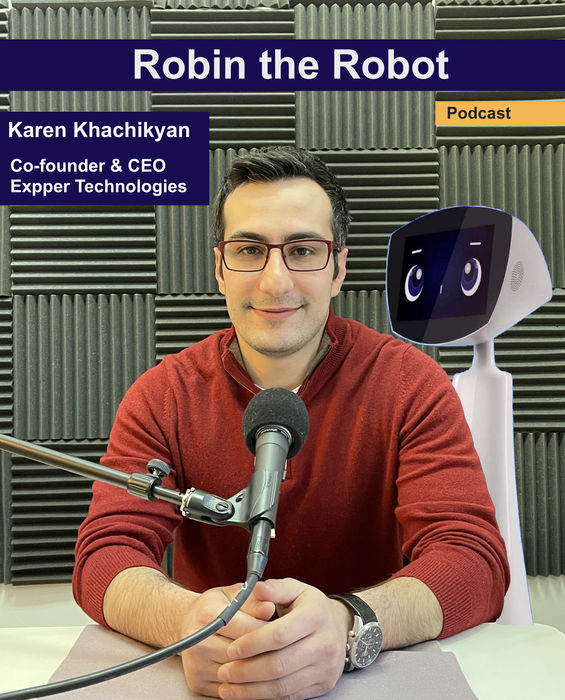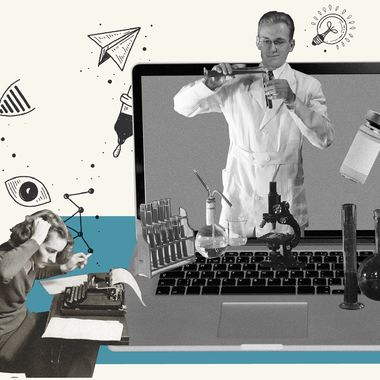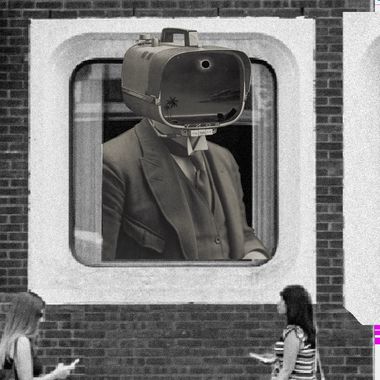Thu May 13 2021 · 7 min read
Edu2work: A Navigation Tool Bridging the Gap Between Education and Labor Markets

By Ruzanna Baldryan

Illustration by Armine Shahbazyan.
The Mismatch
“In Armenia, we don’t say, ‘I didn’t pass the interview.’ We say, ‘Sagh tsanotova.’” The latter is the Armenian expression for “It’s all about who you know.” This ironic social media post by an Armenian job posting website portrays the widespread public perception that education and soft skills won’t land one a job in Armenia, but an acquaintance or a network will. Although it might still be true for some part of the population, this trend is slowly ebbing. In our highly uncertain world, which is rapidly undergoing technological changes, a tech-savvy workforce with problem-solving, adaptability and communications know-how is a must. Yet, our workforce is still being prepared for a “one job for life” model with a standardized education fit for the needs of a 20th century labor market. Even in Armenia, the approach is outdated; one study showed that competitive employees could change their job seven times throughout their career.
In his piece, “Independence Generation: Education, Societal Aspirations and Implications for Development,” Narek Manukyan examines the nature of Armenian public perceptions in the context of a developing country with an education system in transition. Unsurprisingly, not only do the youth have low trust in the education system and don’t see the utilitarian value of education in real life, but they also brush aside practical skills. Instead, they focus on getting a university diploma, believing it to be one of the key means of landing a job, even if it’s not in the field of their studies.
However, holding a diploma doesn’t necessarily secure a job. Essentially, most of the 156 employers from various industries interviewed for the “Involvement of a highly qualified labor force in the Armenian labor market” study conducted by the Institute of Public Policy back in 2019 attached more importance to employee skill sets, rather than the degree they acquired upon exiting university. As they mention, diplomas and certificates don’t imply higher productivity on the part of the individual. The reasoning is that the lack of information on changes in the economy and labor market signals condones the outdated curricula and instruction methodologies of the universities, which ignore the modern-day requirements for employee skills and personal values.
Therefore, students do not gain tangible soft skills to help them translate their education into employment, and they do not take up life-long learning habits which are a precondition for competitive advantage, greater labor productivity, and efficient business performance. Their expertise is long outdated or in oversupply by the time they graduate, thus expanding the gap between the education system and labor market needs. Additionally, taking on employees who are underperforming, inflexible, and fall short of completing the tasks they are needed for forces employers to spend money on retraining and upskilling their staff. It hinders their business growth, and curbs technological investments and innovation opportunities in the long run.
Today, there are around 1.3 billion people whose competencies either exceed or are insufficient for the tasks they perform, and this number is projected to grow to more than 1.4 billion by 2030. This ever-growing chronic mismatch between the education system and job market is the result of a lack of communication between all players involved in the education to work transition process, including policymakers, the private sector and educational institutions. This in turn implies ineffective use of resources for the economy, loss of human capital, structural and long-term youth unemployment, and social exclusion.
The Crisis and the Growing Gap
In 2019, the youth unemployment rate in Armenia was 32.6% (of the total labor force aged 15-24). Apart from the underutilization of human resources, the Armenian labor market can also be characterized by low activity rates, regional differences in employment, and the problem of external labor migration.
This situation was exacerbated by the COVID-19 crisis, which disrupted labor markets globally in 2020. Countries and people across the world are still experiencing post-pandemic recovery challenges, and despite the development of new vaccines, the widespread rebound from COVID-19 may take years. Although the long-term economic implications of the 2020 crises are yet to be estimated, according to a recent report by the World Bank, Armenia had one of the most drastic GDP cuts in the region in 2020—7.6 %, affecting the unemployment rate, as well.
Nonetheless, history has proven that any crisis can offer opportunities. What if we could use the pandemic as a turning point for, not only rethinking the nature of work, but also how we reposition the education system so that it matches anticipated labor market transformations during and after a global crisis?
Edu2Work: A Labor Market Navigation Tool
Becoming faster at utilizing all available data sources for better decision-making at all levels, starting from students to policymakers, is the most viable way to remain flexible and adaptable in an ever-changing labor market, where COVID-19 is yet another variable demanding shifts and adaptation on all fronts. In the years to come, the world will get better at collectively facing the threat of similar pandemics, but there are no guarantees that new crises will not emerge, demanding more flexibility and adaptation.
Having in mind the existing gap of information on labor market trends and the lack of coordination between policymakers, students, educators and business leaders, an idea to create a platform where all of these players could navigate through the labor market and make data-driven decisions came to life.
As a result, Armenia National SDG Innovation Lab—a joint initiative of the Government of Armenia and the UN, which has been re-evaluating decision-making practices in Armenia and mainstreaming innovation for the past three years by introducing behavioral experiments and adding more data as the antidotes to ephemeral policy choices—teamed up with Burning Glass Technologies, a world leader in labor market analysis through big data, to create a local AI-powered solution. The platform, dubbed Edu2work, analyzes thousands of online job postings from a wide variety of commercial websites to provide insights into the labor market. For full disclosure, I work at the Armenia National SDG Innovation Lab and am a co-founder of the Edu2work project.
Edu2work was created with three main user groups in mind: policymakers and research centers, students and career navigators, and universities and other educational institutions. The platform offers solutions tailored to each of the groups. It visualizes the key insights of the demand side of the labor market: the most in-demand professions, skills, education and experience levels that are needed to land the dream job. Moreover, one can spot all of the professions and skills that top industries and employers are looking for. Based on an analysis of trends, the Forecast section of the platform provides insights on what to anticipate in the labor market. Last but not least, the Your place in the market section is a guide to finding the perfect match by career and its relevant active job openings.
In parallel to the development of the platform, a qualitative study was conducted by the Institute of Public Policy to validate insights from online announcement data and to try to get a holistic picture of the market. As the study suggests, employers do demand a tech-savvy workforce with complex problem-solving and project management ability, flexibility, creative thinking, and communications know-how. Moreover, in the case of the most demanded jobs, employers favor skills and knowledge over formal education.
So, what?
By analyzing every nook and cranny of the job market reflected in online job announcements, not only does the platform debunk job-related societal perceptions, but it also gives a real-time snapshot of the labor market, helping to monitor trends and detect changes as they occur instead of post-factum observations.
Students can get a picture of the job market, make evidence-based career choices and choose where and how to use their time and skills afterward. Equally, educational institutions and career navigators can assess the relevance of their curricula and develop educational programs tailored to the needs of employers. Real-time insights can help better channel the life-long learning processes that could counteract the obsolescence of diplomas, provide knowledge and reskilling opportunities in the face of a rapidly transforming labor market, and train for activities that do not yet exist.
Additionally, policymakers can spot emerging opportunities for workforce re-skilling in the face of future challenges and tap into them to ensure sustainable growth with decent and productive work for all, despite the changing genome of jobs and skills.
By providing a consolidated source of information on the competitive job market, Edu2work acts like a unified platform for policymakers, educational institutions, and the private sector, who can share a common vision for the future and now better understand each other.
Creative Tech
The Myth of “National” Science
By Gagik Tovmasian
The current state and future direction of science in Armenia has been discussed on various platforms recently. Gagik Tovmasian writes about the need to elevate the status of national institutes and willingness to open up to the world.
Gitak: Bridging Students With Supervisors for Science Research
By Tatev Mkrtumyan
With the absence of qualified academic supervisors and challenges with the quality of student research, there was a need to develop a platform where students and supervisors could meet remotely.
Legal Institutions for an Emerging Technology Economy
By Henry Nikogosyan
On the path to becoming a serious player in the global tech sector, Armenia needs to foster an environment that allows technology companies to achieve their business goals, which includes legal institutions to resolve complex disputes.
High Tech, Low Culture: Armenian Creative Industries and New Media
By Vahram Akimyan
This is not a cyberpunk essay about a dystopian future, but rather an attempt to take a pragmatic look at creative industries and the landscape of digital culture in Armenia.
also read
Are We Ready for the Next Cyber War?
By Paruyr Abrahamyan
Armenia is at the wrong end of global cyber security indexes. The lack of a comprehensive cyber security national policy makes the country's network and information systems vulnerable. The 2020 Artsakh War clearly proved this.
listen to









